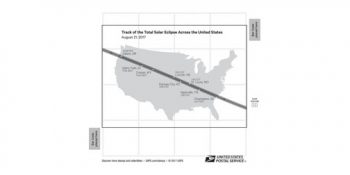Thermal-powered postage stamp transforms with the heat from a fingertip
What: At a public ceremony in Laramie, WY, the United States Postal Service will unveil the Total Eclipse of the Sun Forever stamp . The ceremony will be the national debut of this first-of-its-kind stamp that transforms using the heat of a finger. By touching the stamp image of the eclipse, an underlying image of the Moon will be revealed. Once the stamp cools, the image reverts back to the eclipse. The stamp will be sold at Post Offices nationwide.


When:
Tuesday, June 20, 2017, 1:30 P.M.
This event follows the University of Wyoming Art Museum’s annual summer solstice celebration from 11:30 a.m.-12:30 p.m. At exactly noon, the sun shines through a solar tube in the ceiling of the Rotunda Gallery and illuminates a silver dollar that is set into the center of the gallery’s floor.
(If you are coming, please RSVP so we can make sure you are properly accommodated)
Where:
University of Wyoming Art Museum
Laramie Wyoming
Who:
Dr. Madhulika Guhathakurta, NASA Astrophysicist
Chip Kobulnicky, University of Wyoming Department of Physics and Astronomy Professor
Fred Espenak, Photographer of stamp image, Eclipse expert
Kevin Romero, Acting District Manager, Colorado/Wyoming District, USPS
Jim Cochrane,, Chief Customer and Marketing Officer and Executive Vice President, USPS
Background:
A total eclipse of the Sun will occur on Aug. 21. The solar eclipse happens as the Moon completely blocks the visible solar disk from view, casting a shadow on Earth. Tens of millions of people in the United States hope to view this rare event, which has not been seen on the U.S. mainland since 1979. The eclipse will travel a narrow path across the entire country for the first time since 1918.
The 70-mile-wide shadow path of the eclipse, known as the “path of totality,” will traverse the country diagonally, appearing first in Oregon (mid-morning local time) and exiting some 2,500 miles east and 90 minutes later off the coast of South Carolina (mid-afternoon local time) passing through portions of 14 states.
The Total Eclipse of the Sun stamp image is from a photograph taken by retired NASA astrophysicist Fred Espenak of Portal, AZ, who is considered by many to be the world’s leading authority on total solar eclipses with 27 under his belt. The photograph shows a total solar eclipse seen from Jalu, Libya, on March 29, 2006.
“I’m honored to have my images on this unique stamp,” said Espenak, who began collecting eclipse stamps after witnessing his first as a teenager. “A total eclipse of the Sun is simply the most beautiful, stunning and awe-inspiring astronomical event you can see with the naked eye.”
The Stamps:
The pane of 16 Forever stamps are available at Post Office facilities nationwide on June 20 and may also be ordered online for home delivery.
In the first U.S. stamp application of thermochromic ink, the Total Solar Eclipse stamps will reveal a second image. Using the body heat of your thumb or fingers and rubbing the eclipse image will reveal an underlying image of the Moon. The image reverts back to the eclipse once it cools.
Thermochromic inks are vulnerable to UV light and should be kept out of direct sunlight as much as possible to preserve this special effect. To help ensure longevity, the Postal Service is offering a special envelope to hold and protect the stamp pane for a nominal fee.
Art director Antonio Alcalá of Alexandria, VA, designed the stamp.
The Total Eclipse of the Sun stamp is being issued as a Forever stamp, which is always equal in value to the current First-Class Mail 1-ounce price.
The Postal Service receives no tax dollars for operating expenses and relies on the sale of postage, products and services to fund its operations.

Leave a Reply